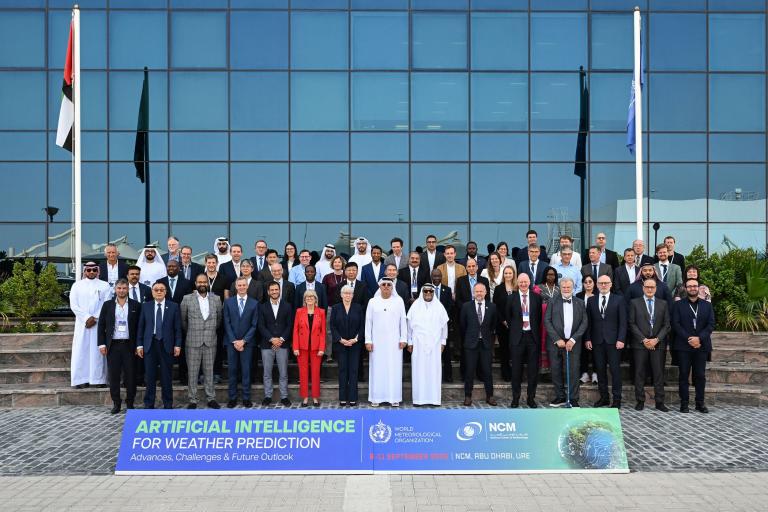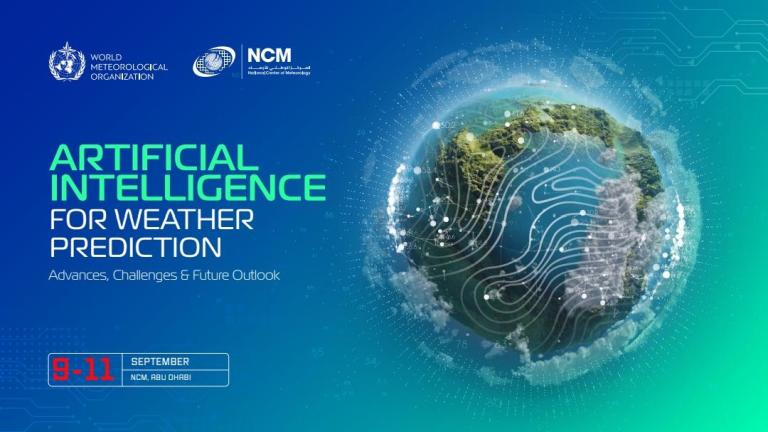Artificial intelligence (AI) is set to revolutionize the way the world predicts weather and responds to environmental challenges. In view of the immense opportunities and potential pitfalls, the World Meteorological Organization (WMO) and the National Center of Meteorology (NCM) of the United Arab Emirates convened a pioneering conference to ensure that benefits are spread equitably for the global good.
The three-day event from 9-11 September in Abu Dhabi brought together more than 50 international experts from WMO, the European Centre for Medium-Range Weather Forecasts, National Meteorological and Hydrological Services, academia and the private sector, including Google, IBM, Microsoft, NVIDIA, Tomorrow.io, Brightband and the HydroMeteorological and Environmental Industry.
"We must harness the power of prediction. We must adopt AI-powered weather and climate intelligence into every early warning and decision-making system-because lives depend on it," said WMO Deputy Secretary-General Ko Barrett.
The WMO AI Conference: AI for Weather Prediction, Advances, Challenges & Future Outlook issued a concluding statement stressing the importance of shared benefit for all.
"The global meteorological community must invest in shared and open data and tooling, coordinated open benchmarks, and human-centred service design. This approach will ensure that AI tools are not only powerful, but also trusted, transparent, interoperable and tailored to the needs of diverse users-including those currently underserved by early warning systems. Existing technical and capacity development frameworks should be leveraged to build global capability rapidly," said the statement.

The conference statement also affirmed the need for:
- Investment in capacity and training, and expansion of AI-based pilot projects, focussing on regionally-based implementation and narrowing the digital divide.
- Respect for the authoritative role of National Meteorological and Hydrological Services services in producing official warnings, based on public trust and scientific rigour.
- Dialogue on public and private datasets to fully realize the opportunities afforded by AI, with greater openness at the national level in terms of additional observational and auxiliary data that will be needed.
- Continued support to the underlying observation infrastructure and physics-based systems.
- Common principles to guide the responsible and effective integration of AI into meteorological, climate, hydrological and environmental services. These should be grounded in transparency, collaboration, sustainability, innovation and ethics.
- Continued dialogue at multiple levels, as well as increased representation of the private sector and academia in relevant WMO working structures.
"The world has seen a fundamental shift in the past three years. Artificial intelligence has moved out of the research laboratories and into our living rooms, classrooms and Parliaments," said WMO President Abdulla Al Mandous.
"We see forecasts powered by AI emerging at remarkable speed, driven in part by the collaboration between the private sector, academia and our own NMHSs in various parts of the world," he said.
Pilot Projects
WMO is already exploring the potential of AI to save lives and livelihoods through projects on the ground, thanks in part to funding from the Climate Risk and Early Warning Systems Initiative.
- WMO is piloting AI for flood forecasting in Nigeria, Viet Nam, Uruguay, and the Czech Republic.
- A pilot project in Malawi between MET Norway and Malawi's Department of Climate Change and Meteorological Service seeks to close critical capacity gaps in Malawi and more generally in Least Developed Countries and Small Island Developing States.
- WMO is enabling Regional Climate Centres in Africa, the Caribbean, and the Pacific to apply AI in sub-seasonal forecasting.
- Together with the private sector, WMO is piloting AI-based nowcasting tools across three continents, including in Asia.
"We are clear that AI still has limitations, particularly for localized high-impact events, and these challenges must be resolved before large-scale deployment. This is another reason to join forces to ensure we can all trust what fuels our early warning systems," said Ko Barrett.
WMO's Executive Council in June agreed on an action plan on AI, including the establishment of a new Joint Advisory Group.
The WMO AI conference statement will serve as a shared vision and will inform discussions at the WMO Extraordinary Congress from 20-24 October .







